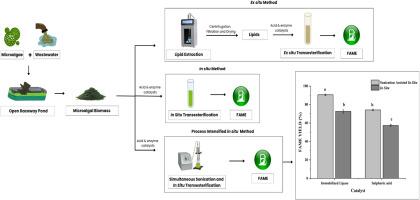固定化脂肪酶对废水培养的马氏酵母生物质的原位酯交换反应研究
IF 3.9
3区 工程技术
Q3 ENERGY & FUELS
Chemical Engineering and Processing - Process Intensification
Pub Date : 2025-10-04
DOI:10.1016/j.cep.2025.110580
引用次数: 0
摘要
微藻可作为发展生物柴油可持续生产的潜在原料。本研究探讨了在营养优化废水(OWW)中培养马氏酵母(Marvania cocides)生产生物柴油的过程,主要重点是评估和比较原位和非原位酯交换过程。OWW生物量达到937.5±17.68 mg。L-1生物量产率为19.8±0.99%,适合生产生物柴油。元素分析显示其碳和氧含量高,支持生物燃料的潜力。微藻脂质酸值为10.71±0.72 mg KOH。G-1表示酶和酸催化的必要性。固定化脂肪酶催化的脂肪酸甲酯(FAME)收率最高,分别为91.95±0.32%和72.54±0.84%。然而,在超声的辅助下,进一步强化工艺可以提高原位酯交换的FAME收率,在固定化脂肪酶的催化下,FAME收率最高可达90.65±0.77%。此外,催化剂可重复利用性研究表明,固定化脂肪酶在第4次循环时的FAME产率为64.2±0.84%。GCHRMS分析显示,主要脂肪酸的存在提高了生物柴油的质量。生物柴油燃料性能符合ASTM D6751和EN 14,214标准,表明微藻通过原位酯交换在生物柴油生产中的潜力。本文章由计算机程序翻译,如有差异,请以英文原文为准。

Process-intensified in-situ transesterification of wastewater-grown Marvania coccoides biomass using immobilized lipase for biodiesel production
Microalgae can serve as a potential raw material for the development of sustainable biodiesel production. This study explores biodiesel production from Marvania coccoides cultivated in nutrient optimized wastewater (OWW), with a primary focus on evaluating and comparing in-situ and ex-situ transesterification processes. The OWW biomass achieved 937.5 ± 17.68 mg.L-1 biomass yield with lipid content of 19.8 ± 0.99 %, indicating the suitability for biodiesel production. The elemental analysis showed high carbon and oxygen content, supporting its potential for biofuel. The acid value of microalgal lipids was found to be 10.71 ± 0.72 mg KOH.g-1 indicating the necessity for enzyme and acid catalysis. Transesterification carried out using ex-situ and in-situ methods showed the highest fatty acid methyl esters (FAME) yield of 91.95 ± 0.32 % and 72.54 ± 0.84 %, respectively with immobilized lipase as catalyst. However, further process intensification assisted by sonication enhanced the FAME yield of in-situ transesterification, which showed a maximum FAME yield of 90.65 ± 0.77 % with immobilized lipase as a catalyst. Further, the catalyst reusability study demonstrated that immobilized lipase showed FAME yield of 64.2 ± 0.84 % in the fourth cycle. GC![]() HRMS analysis revealed the presence of major fatty acids enhancing biodiesel quality. The biodiesel fuel properties comply with ASTM D6751 and EN 14,214 standards, indicating the potential of microalgae in biodiesel production through in-situ transesterification.
HRMS analysis revealed the presence of major fatty acids enhancing biodiesel quality. The biodiesel fuel properties comply with ASTM D6751 and EN 14,214 standards, indicating the potential of microalgae in biodiesel production through in-situ transesterification.
求助全文
通过发布文献求助,成功后即可免费获取论文全文。
去求助
来源期刊
CiteScore
7.80
自引率
9.30%
发文量
408
审稿时长
49 days
期刊介绍:
Chemical Engineering and Processing: Process Intensification is intended for practicing researchers in industry and academia, working in the field of Process Engineering and related to the subject of Process Intensification.Articles published in the Journal demonstrate how novel discoveries, developments and theories in the field of Process Engineering and in particular Process Intensification may be used for analysis and design of innovative equipment and processing methods with substantially improved sustainability, efficiency and environmental performance.

 求助内容:
求助内容: 应助结果提醒方式:
应助结果提醒方式:


